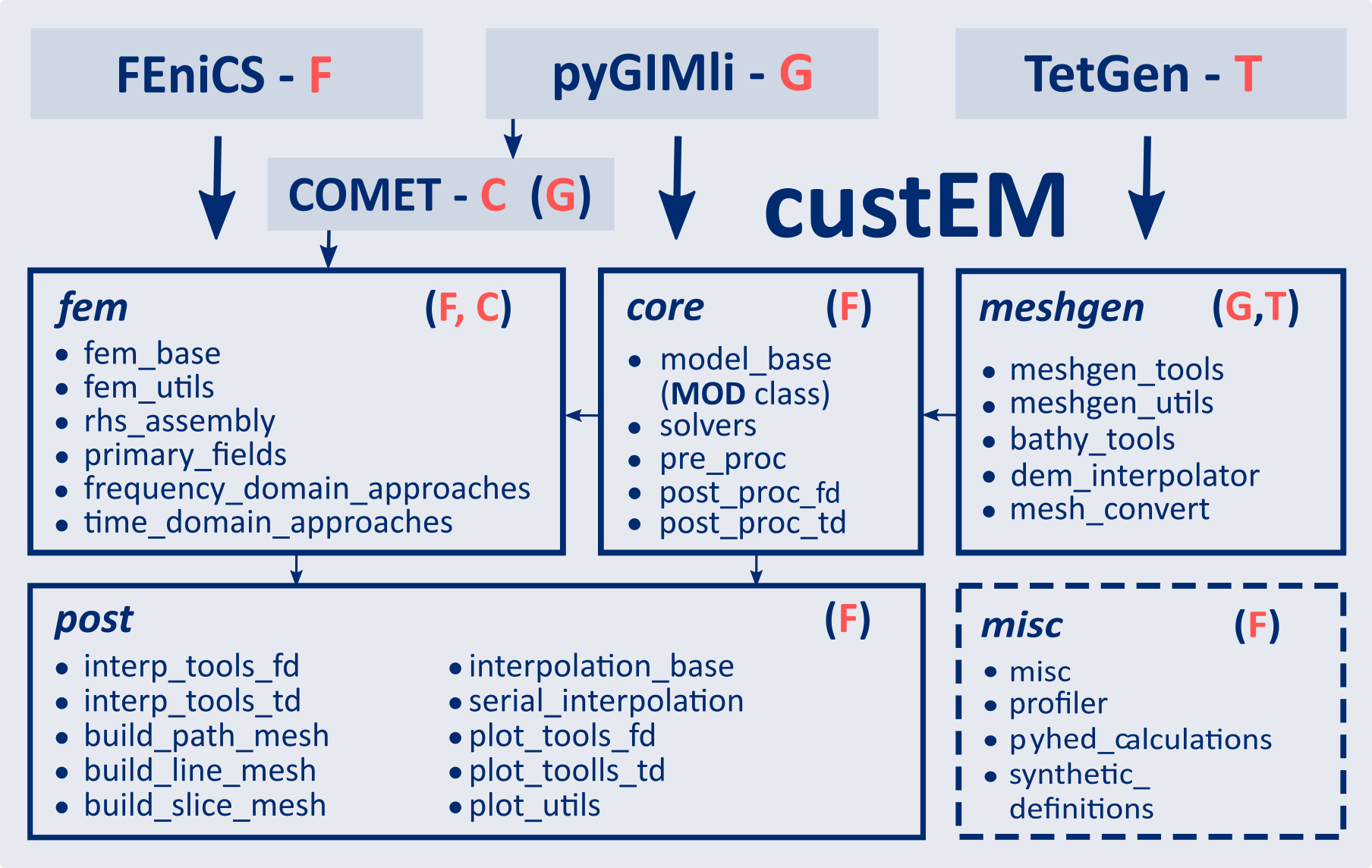Welcome to custEM!
Version: 1.5. ~ Date: Mar 18, 2024
The Python toolbox custEM is an open-source development for customizable 3D finite-element modeling and inversion of controlled-source, transient, and natural-source electromagnetic data. The toolbox is based on the finite-element library FEniCS, see https://fenicsproject.org/ . Different total and secondary electric or magnetic field as well as gauged-potential approaches are implemented. In addition, custEM contains a mesh generation submodule for the straightforward generation of tetrahedral meshes supporting a large number of marine, land-based, airborne or mixed model scenarios. Interpolation and visualization tools simplify the post-processing workflow. The latest version of custEM include tools to calculate sensitivites for the 3D inversion of CSEM data in combined usage with the pyGIMLi library.
Mesh generation runs on any laptop or desktop PC. Also minimalistic examples can be tested on such machines. Because of using direct solvers, we recommend to get access to a cluster with >= 32 cores/threads and >=256 GB RAM for calculating sufficiently accurate models for more complex 3D setups. However, quite good results for simpler 3D modeling studies often require only 32-64 GB.
Please note that custEM is under continuous development. For information about planned updates and previous development steps we refer to the Development section. Do not hesitate to contact raphael.rochlitz@leibniz-liag.de for any kind of question about custEM or discovered issues in the code, examples, or the documentation.
Getting started
To guide you through setting up the toolbox and making third party dependencies available, please follow the Installation notes. After A successful installation, user could run any of the test files provided in the corresponding directory. In addition to these initial tests for the overall functionality of custEM, we refer to the provided examples. The first four frequency-domain and first three time-domain examples correspond to the ones presented by (Rochlitz et al., 2019) & (Rochlitz et al., 2021), respectively. Further advise to develop solution strategies for user-specific modeling problems is provided by the tutorials.
In addition, we recommend to read the Tips&Tricks section, which contains further practical advise based on our modeling experiences.
Installation
For instructions, it is referred to the Installation section.
Documentation
The python API documentation is available online on ReadtheDocs. In, addition, the complete API documentation is available as “hmtl_doc” zip-file in the docs directory of the custEM repository and can be accessed via opening the “index.html” file in the zip directory with your favorite browser.
The Source code documentation content is generated automatically when publishing new custEM versions. Detailed information about specific functionalities might be accessed with help of the Index or using the Search Page.

Overview of Third-party dependencies and modules in custEM
Tutorials
Tutorials are available in the tutorials directory in the custEM repository as jupyter notebook, python script, and in html format. The html documentation of the Tutorials can be also accessed in the corresponding section. Please note that the usage of jupyter notebooks is not straightforward in combination with multiprocessing. For running the run_tutorial, please use the provided run_tutorial.py script and call it from the command line with the mpirun syntax:
–> mpirun -n x python run_tutorial.py
with x, the number of MPI processes.
Examples
A description of CSEM, TEM, MT modeling examples and our latest semi-airborne data inversion examples can be found here.
Due to the increasing extent of examples, we moved them all from the code repository to a seperate example repository, see:
GitLab examples repository: https://gitlab.com/Rochlitz.R/custem-examples
License
Copyright 2016-2023 by R. Rochlitz
The custEM toolbox is licensed under the GNU LESSER GENERAL PUBLIC LICENSE (LGPL). The terms are listed here License.
References
Rochlitz, R., Günther, T. and Becken, M. (2023), Three-dimensional inversion of semi-airborne electromagnetic data with a second-order finite-element forward solver. Geophysical Journal International, ggad056 (accepted manuscript), https://doi.org/10.1093/gji/ggad056
Rochlitz, R., (2022), From open-source 3D EM modeling towards inversion, EMinar, 16.03.2022, https://www.youtube.com/watch?v=c_pHSD_ZyS8
Rochlitz, R., Seidel, M. and Börner, R.-U. (2021), Evaluation of three approaches for simulating time-domain electromagnetic data using the open-source software custEM, Geophysical Journal International, 227(3), 1980-1995, https://doi.org/10.1093/gji/ggab302
Werthmüller, D., Rochlitz, R., Castillo-Reyes, O. and Heagy, L. (2021), Towards an open-source landscape for 3-D CSEM modelling, Geophysical Journal International, 227(1), 644-659, https://doi.org/10.1093/gji/ggab238
Rochlitz, R. and Günther, T.,(2021), Open-Source 3D Finite Element Modeling of Electromagnetic data with custEM 1.0, No. EGU21-11123, Copernicus Meetings, Pico presentation, https://presentations.copernicus.org/EGU21/EGU21-11123_presentation.pdf
Rochlitz, R. (2020), Analysis and open-source Implementation of Finite Element Modeling techniques for Controlled-Source Electromagnetics, PhD thesis, Westfälische Wilhelms-Universität Münster, Germany. https://drive.google.com/file/d/1cPm_dfpXKryxKCdq3sX9u4p13VF2dYDB
Rochlitz, R., Skibbe, N. and Günther, T. (2019), custEM: customizable finite element simulation of complex controlled-source electromagnetic data, GEOPHYSICS Software and Algorithms, 84(2), F17-F33, https://doi.org/10.1190/geo2018-0208.1
Next to us, don’t forget to give credits to the authors of FEniCS, pyGIMLi, TetGen, COMET and empymod if submodules based on their developments are used.